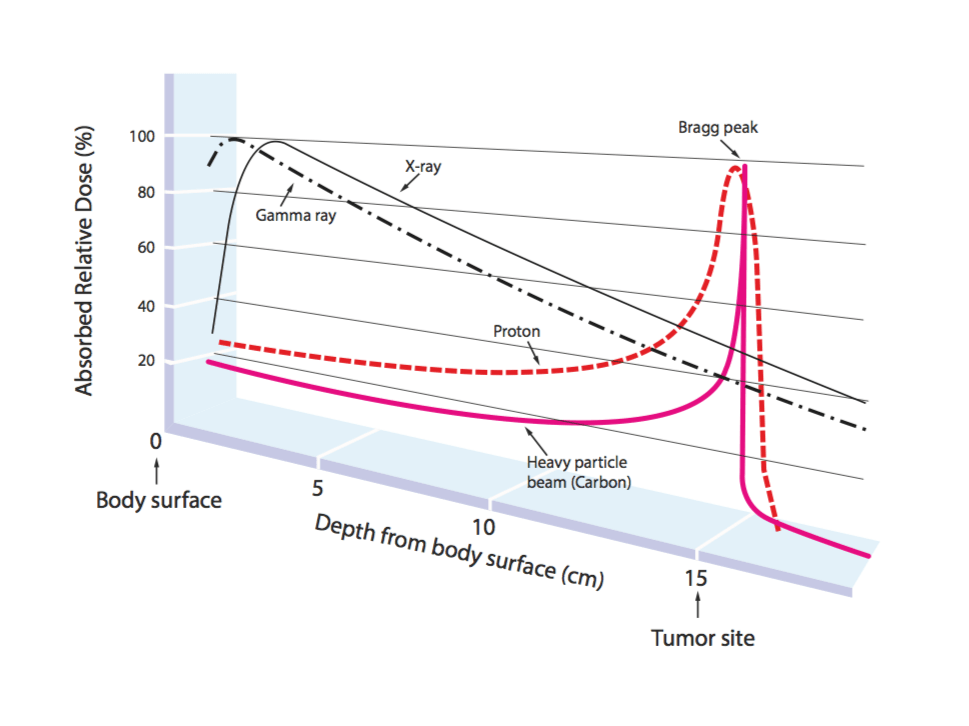Proton therapy
The most advanced and evolved treatment for curing tumors.
What is Proton Therapy
Proton therapy, also known as proton beam therapy, is a form of radiation therapy used to treat cancer. It selectively targets tumors while preserving healthy tissues and allows for the administration of higher radiation doses, thereby increasing the likelihood of treatment success. Unlike conventional radiotherapy, which uses X-rays or electrons, proton therapy utilizes protons, which are heavier atomic particles with greater energy than electrons, making them more precise and effective. In proton therapy, energy is released at a specific depth within the tissue, corresponding to the so-called Bragg peak. The use of protons for cancer treatment was first proposed in the 1940s and was experimented with in the 1950s. However, it wasn’t until the 1990s that the first hospital dedicated to this therapy was built in America, at Loma Linda, which remains a global reference point to this day. Since then, more than 60 facilities have been established worldwide, with many others under construction or planned. The number of patients treated worldwide exceeds 130,000.
It is estimated that by 2030, 226,000 patients could be treated with proton therapy compared to the 20,500 patients treated in 2016.
(Fonte: MEDraysIntell)
What are protons
Protons are heavy subatomic particles with a positive electric charge. They release the maximum radiation dose at the end of their path. This physical characteristic is determined by the Bragg Peak. Due to their relatively large mass, protons exhibit minimal lateral dispersion when traversing tissues; thus, the beam does not spread, remaining focused on the tumor mass and thereby ensuring minimal collateral damage to surrounding tissues. All protons of a given energy have a specific penetration power, so only a few protons penetrate beyond a certain distance, sparing the tissues behind the tumor.


Proton therapy significantly reduces the risk of long-term side effects and is particularly suitable for patients with a long life expectancy after treatment.
(Fonte: MEDraysIntell)
Bragg peak
The Bragg peak is the curve obtained by plotting the energy lost by a particle penetrating matter against the depth it reaches as it progresses. The “peak” shape of protons shows that these particles release most of their energy at the end of their path, and this important characteristic is exploited in medicine to treat tumors without surgery, using the particles as “depth charges.”
Healthcare professionals, by adjusting the energy of the protons, gain control of the proton beam, which thus releases the tumoricidal dose only in the last millimeters of its path, precisely on target.

Proton therapy will completely replace conventional radiotherapy in a large number of indications.
(Fonte: MEDraysIntell)
What types of cancer can be treated with proton therapy?
What types of cancer can be treated with proton therapy?
All tumors currently treated with conventional radiotherapy can be treated with proton therapy, especially those close to vital organs (head and neck region). It is indicated in cases of radio-induced tumors (arising in patients previously treated with conventional radiotherapy) and for all pediatric solid tumors, as it allows for minimal impact on children.
5 reasons to choose ERHA, the Enhanced Radiotherapy with Hadrons
Lower price compared to existing systems.
Respect for the environment: it has almost negligible both instant and induced radiations, it avoids the need for large amounts of concrete shielding and it reduces problems of decommissioning and disposal of radioactive waste at the end of its life (20-30 years).
Small footprint: our structure extends mostly in length and requires a surface area of less than 100sqm. Therefore, it has very little impact compared to existing PT structures.
Easy to set up in a shielded corridor, a warehouse or a parking lot, as it requires only a small flat surface.
Ease of management by operators: the number of devices is reduced and control is achieved by a single software interface.
Linearbeam ERHA Proton Therapy System is not yet approved for clinical use.

